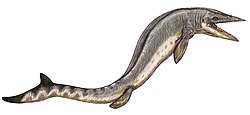Top Qs
Timeline
Chat
Perspective
Snow Hill Island Formation
Geologic formation in Antarctica From Wikipedia, the free encyclopedia
Remove ads
The Snow Hill Island Formation is an Early Maastrichtian geologic formation found on James Ross Island, James Ross Island group, Antarctica.[1] Remains of a paravian theropod Imperobator antarcticus[2] have been recovered from it, as well as the elasmarian ornithopods Trinisaura santamartaensis, "Biscoveosaurus" and Morrosaurus antarcticus, the ankylosaurian Antarctopelta oliveroi, and the shark Notidanodon sp. Alongside these described genera are also the remains of indeterminate elasmosaurids,[3] lithostrotian titanosaurs and an indeterminate pterosaur.[4]
In the Herbert Sound Member of the Snow Hill Island Formation, bivalves, ammonites, and fish were found.[5]
Remove ads
Fossil content
Summarize
Perspective
Invertebrates
Corals
Arthropoda
Mollusks
Vertebrates
Fish
Pterosaurs
Dinosaurs
Plesiosaurs
Mosasaurs
Plants
Color key
|
Notes Uncertain or tentative taxa are in small text; |
During the Campanian–Maastrichtian, the Antarctic Peninsula supported temperate, humid forests dominated by podocarps, araucarian conifers, and a diversifying group of angiosperms. Key angiosperm families included Nothofagaceae, Monimiaceae, Cunoniaceae, Proteaceae, Myrtaceae, Lauraceae, Atherospermataceae, Winteraceae, and extinct Sassafras-like forms.[41][42] Another important group is Asteraceae, with Dasyphyllum-like pollen, the oldest fossils ever found for the family.[43] Ferns such as Osmundaceae and Gleicheniaceae formed part of the understorey. Fossil evidence (wood, pollen, leaves) comes mainly from Seymour, Vega, James Ross, and Snow Hill islands. Forests were structurally similar to modern Valdivian temperate forests. The flora reflects a transition from gymnosperm-dominated to mixed angiosperm-conifer ecosystems under polar greenhouse conditions.[41][44]
Remove ads
See also
References
Further reading
Wikiwand - on
Seamless Wikipedia browsing. On steroids.
Remove ads


















